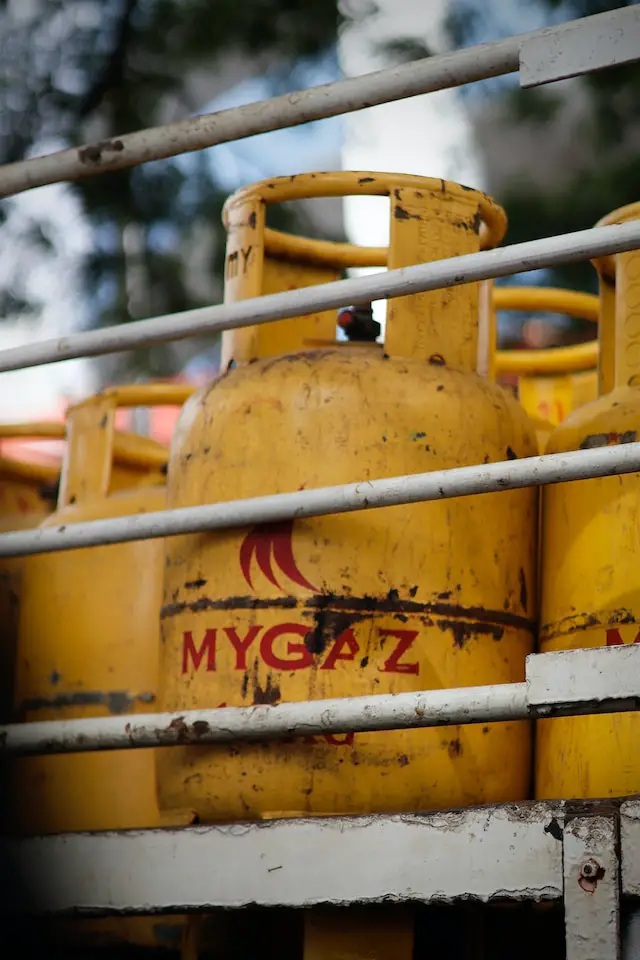Oil and gas both come from the earth’s natural resources, they have distinct differences in their properties and uses. Oil is a liquid fossil fuel that is used primarily for transportation and as a source of energy. Gas, on the other hand, can be either natural gas or liquefied petroleum gas (LPG) and it is commonly used for heating buildings or cooking.
What is oil?
(Photo by André Robillard on Unsplash )

Oil, also known as petroleum, is a fossil fuel that has been formed over millions of years from the remains of ancient plants and animals. It is found deep beneath the earth’s surface and can be extracted using drilling techniques.
Crude oil is made up of various hydrocarbons, which are molecules composed of hydrogen and carbon atoms. These hydrocarbons differ in size and complexity, ranging from small chains to large rings.
Once extracted from the ground, crude oil undergoes a refining process where it is separated into different components based on their boiling points. This results in products such as gasoline, diesel fuel, jet fuel, lubricating oils and asphalt.
The demand for oil has grown exponentially since its discovery due to its versatility as an energy source. However, this demand comes with environmental concerns such as air pollution and greenhouse gas emissions.
Despite these drawbacks, oil remains a crucial resource for many industries around the world. From powering vehicles to heating homes and generating electricity – it plays a major role in our daily lives.
What is gas?
(Photo by You Le on Unsplash )

Gas is a type of fossil fuel that occurs naturally in the earth’s crust. It is made up of hydrocarbons, which are molecules composed of hydrogen and carbon atoms. Unlike oil, gas is not a liquid but rather exists as either a gas or a mixture of gases. The most common type of natural gas is methane.
Natural gas can be found underground in rock formations or trapped beneath layers of shale. In order to extract it, wells must be drilled deep into the ground and then the gas must be transported to storage facilities before being distributed for use.
One major advantage of using natural gas over other forms of energy is its relatively low cost and abundance. It has become increasingly popular as an alternative to more expensive fuels like coal or oil.
However, there are also concerns about the environmental impact associated with extracting and burning natural gas. Methane emissions from drilling operations pose serious risks to local air quality, while pipelines transporting natural gas have been known to leak harmful chemicals into nearby water sources.
Many people still view natural gas as a viable source of energy for powering homes and businesses alike.
Oil Vs. Gas – Key differences
Oil and gas are two of the most important natural resources that we use in our daily lives. They have many similarities but also some key differences. One of the biggest differences between oil and gas is their physical state at room temperature. Oil is a liquid, while natural gas is a gas – hence their names.
Another major difference between oil and gas is how they are used. Oil has traditionally been used as fuel for transportation, heating homes, generating electricity and manufacturing goods such as plastics and chemicals. On the other hand, natural gas has historically been used mainly for heating buildings or cooking food in households.
The chemical composition of these two substances also differs significantly from one another. While both come from organic matter, oil contains mostly hydrocarbons with higher molecular weights than those found in natural gas.
In terms of production costs, there can be significant variances between drilling for oil versus drilling for natural gas due to different geological formations where each resource may occur.
When it comes to environmental impact, burning fossil fuels like oil releases more carbon dioxide into the atmosphere than using natural gases would do so on average; which can contribute to climate change over time if not mitigated by various strategies including reducing consumption or increasing renewable energy adoption rates globally.
Where do oil and gas come from?
Oil and gas are hydrocarbons that come from a variety of sources. One of the primary sources for both oil and natural gas is ancient organic matter, such as algae and plankton, which were buried under sedimentary rock layers millions of years ago.
Over time, heat and pressure transformed this organic material into fossil fuels. The amount of heat applied determines whether the result will be oil or gas. Oil forms when there is less heat, while gas forms when temperatures reach higher levels.
Another source for natural gas is shale rock formations deep beneath the earth’s surface. This type of natural gas extraction involves drilling down vertically then horizontally to access pockets within the shale where trapped methane exists.
In addition to these traditional sources, researchers are exploring ways to produce biofuels through sustainable means like agriculture waste conversion or algae farming in an effort to reduce dependence on non-renewable resources like oil and gas.
Regardless of their origin story, it’s clear that we need to explore alternative energy options in order to reduce our reliance on nonrenewable resources like oil and gas before they’re used up completely.
How are oil and gas used?
Oil and gas are two of the most important natural resources on our planet. They have been used for centuries to power everything from transportation to heating and electricity generation.
When it comes to oil, its primary use is as a fuel. It can be refined into gasoline, diesel fuel, jet fuel, and other types of fuels that power vehicles such as cars, trucks, airplanes and boats. Oil is also used in the production of plastics, chemicals and lubricants.
Gas has many uses too. Natural gas is primarily burned for heating homes or generating electricity in power plants. Compressed natural gas (CNG) can be used as an alternative fuel for vehicles too. Liquefied petroleum gas (LPG), which includes propane and butane gases, is commonly used for cooking at home or powering industrial equipment.
Both oil and gas are vital components in modern society’s energy mix but they come with environmental costs that need addressing urgently. Therefore we need to look towards renewable energy alternatives like wind turbines or solar panels instead!
The pros and cons of oil?
Oil has been the backbone of our economy for decades. It’s used in transportation, heating and cooling buildings, manufacturing products, and generating electricity. But like most things in life, oil comes with its fair share of pros and cons.
One major advantage of oil is its versatility. It can be refined into various types of fuels that power everything from cars to airplanes to ships. Additionally, it’s relatively affordable compared to some other forms of energy.
On the flip side, oil production can have significant environmental impacts. Drilling rigs and pipelines can damage natural habitats and disrupt ecosystems. Oil spills are also a risk during transport or extraction.
Another drawback is that oil reserves are finite resources – eventually they will run out. This means that as we continue to rely on oil as our primary source of energy, we must prepare for a future without it.
Using fossil fuels like oil contributes significantly to climate change by releasing carbon dioxide into the atmosphere. As such, transitioning away from these sources towards renewable energy alternatives becomes more pressing every day.
The pros and cons of gas
Gas is a popular source of energy for many households and businesses. It is commonly used for heating homes, cooking food, and generating electricity. However, like any other form of energy, gas has its own set of pros and cons.
One major advantage of using gas is that it burns cleanly when compared to oil or coal. This means that it produces fewer emissions during combustion and generates less pollution overall. Additionally, natural gas is abundant in many parts of the world which makes it an affordable option for consumers.
On the downside, there have been several high-profile accidents related to gas leaks in recent years which highlight some serious safety concerns associated with its use. Furthermore, while natural gas may be relatively clean-burning compared to other fossil fuels, it still contributes significantly to greenhouse gases emissions which contribute to climate change.
Another drawback related to using gas as an energy source is that reserves are finite meaning they will eventually run out someday. As such increasing dependence on this non-renewable resource can lead to future problems when supplies start dwindling.
Though despite these downsides many people continue relying on natural gas due mainly because they believe it offers more advantages than disadvantages making them choose this over other sources such as oil or coal
How can I make the switch to renewable energy?
Making the switch to renewable energy may seem like a daunting task, but it’s actually easier than you think. The first step is to determine what type of renewable energy is available in your area. This could include solar, wind or hydroelectric power.
Once you have identified the available options, you can begin researching different companies and products that offer renewable energy solutions. Look for reviews and testimonials from other customers to help ensure that you choose a reliable provider.
Another option is to install solar panels on your property. This allows you to generate your own electricity using clean, renewable energy sources. Many government programs and incentives exist that can help offset the cost of installation.
If installing solar panels isn’t feasible for your situation, consider purchasing green power from a utility company that generates electricity from renewable sources such as wind or hydroelectric power.
Make small changes in your daily life such as turning off lights when not in use or using energy-efficient appliances can also make a big difference over time.
By taking these steps towards utilizing more renewable energies we are able to limit our negative impact on the environment while still maintaining our modern lifestyle.
Featured Image By – Zbynek Burival on Unsplash








